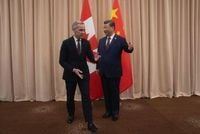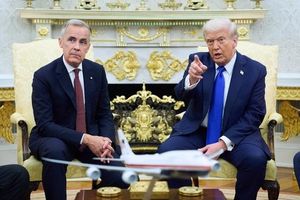In a moment that many observers are calling a significant diplomatic thaw, Canadian Prime Minister Mark Carney and Chinese President Xi Jinping met for formal talks in Gyeongju, South Korea, on October 31, 2025. This encounter, held on the sidelines of the Asia Pacific Economic Cooperation (APEC) summit, marked the first official bilateral meeting between the leaders of Canada and China since 2017—a gap defined by escalating tensions, mutual suspicion, and a series of trade and diplomatic clashes.
Both the timing and the tone of the meeting signaled a deliberate attempt by both nations to reset their relationship after years of frosty exchanges. According to The Canadian Press, Carney described the talks as a “turning point” in restoring battered ties between Ottawa and Beijing. “This meeting marked a turning point in our bilateral relationship. We have now unlocked a path forward,” Carney told reporters after the summit, emphasizing the constructive nature of the discussions.
The road to this meeting has been anything but smooth. Relations between Canada and China plummeted in 2018 following the arrest of a senior Chinese telecom executive in Vancouver on a U.S. warrant—an episode that prompted China to detain two Canadian citizens on espionage charges. The fallout led to tit-for-tat tariffs, notably on Canadian canola, and a diplomatic freeze that left both nations with little appetite for dialogue. As AFP notes, Canada’s relationship with China became one of the most strained among Western countries during this period, with Ottawa accusing Beijing of using trade as leverage and interfering in Canadian elections.
Despite these longstanding grievances, Carney’s meeting with Xi was not expected to yield immediate breakthroughs on contentious issues such as Chinese tariffs on Canadian goods. “Immediate action to reduce Chinese tariffs on Canadian goods such as canola was never a realistic outcome for this meeting,” Carney acknowledged, according to Bloomberg. Instead, the session was widely viewed as an important first step toward restoring dialogue and exploring solutions to complex problems.
Vina Nadjibulla, vice-president of research and strategy at the Asia Pacific Foundation of Canada, echoed this sentiment, calling the meeting an “important first step” and a “turning point” in the bilateral relationship. She added that while no concrete deals were struck, the willingness to engage at the highest level was itself a positive signal for both countries and their economies.
The leaders’ agenda was ambitious, if not exhaustive. According to an official Canadian statement, Carney and Xi discussed “respective sensitivities regarding issues including agriculture and agri-food products, such as canola, as well as seafood and electric vehicles.” These topics have been flashpoints in recent years, with China’s restrictions on Canadian canola exports hitting Canadian farmers hard and Ottawa raising concerns about the fairness of market access for its seafood and electric vehicle industries.
Carney did not shy away from raising difficult subjects. He confirmed that he brought up the issue of alleged Chinese interference in Canadian elections—a topic that has sparked heated debate in Canada and contributed to public mistrust of Beijing. “It was important to have that discussion in order to get relations back on track,” Carney said, underscoring the need for frank dialogue on even the thorniest topics.
For his part, Xi Jinping struck a conciliatory tone in his opening remarks, expressing a willingness to work with Canada to “push China-Canada relations back onto a healthy, stable and sustainable correct track at an early date, to better benefit the people of our two countries.” The invitation for Carney to visit China next year at a mutually convenient time, confirmed by Carney’s office, was widely interpreted as a gesture of goodwill and a sign that Beijing is open to further engagement.
Yet, the backdrop to these talks was anything but serene. Both Canada and China have been grappling with the unpredictable trade policies of U.S. President Donald Trump, whose administration has imposed rapidly changing tariffs that have disrupted global supply chains and complicated bilateral relations for both Ottawa and Beijing. In a candid moment following the APEC summit, Carney disclosed that he had apologized to Trump over an anti-tariff ad campaign that prompted the U.S. president to hike tariffs on Canadian goods by 10% just days before the summit. “I did apologize to the president. The president was offended,” Carney admitted, but he remained unfazed by the uncertainty, insisting, “After all the noise of this week, Canada still has the best trade deal of any country with the US.”
Carney’s remarks reflected a pragmatic approach to diplomacy—one that acknowledges the realities of global trade tensions while seeking to carve out opportunities for Canadian businesses and families. “Distance is not the way to solve problems, not the way to serve our people,” he told journalists, adding, “We now have a turning point in the relationship, a turning point that creates opportunities for Canadian families, for Canadian businesses.”
The symbolism of the meeting was not lost on observers. For years, the absence of high-level talks had become a symbol of the deep freeze in Canada-China relations. The fact that both sides were willing to engage, discuss sensitive issues, and even extend invitations for future visits was seen as a hopeful sign that a new chapter might be opening—one defined by cautious engagement rather than open hostility.
Still, experts caution that the road ahead will be challenging. The fundamental disagreements that have plagued the relationship—over trade, human rights, foreign interference, and geopolitical rivalry—are unlikely to disappear overnight. But as Nadjibulla pointed out, the willingness to talk is a necessary precondition for any progress. “This was an important first step,” she said. “It’s a turning point, but the hard work lies ahead.”
Amidst the diplomatic maneuvering, Carney found a moment to inject some Canadian spirit into the proceedings. Drawing inspiration from the Toronto Blue Jays’ quest to become the first Canadian team to win the World Series since 1993, he remarked, “They take risk, they’re aggressive, and they’re a team... And our Canada is taking risks, and we are a team.” It was a reminder that, even in the rarefied world of high diplomacy, a little optimism—and maybe a bit of baseball bravado—can go a long way.
As the dust settles on this pivotal meeting, the world will be watching to see whether the promises of a “turning point” translate into concrete improvements. For now, the door has been opened, and both Canada and China seem willing to step through—cautiously, perhaps, but with an eye toward a more stable and mutually beneficial future.





